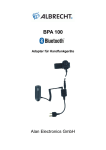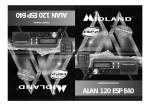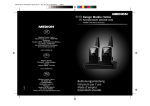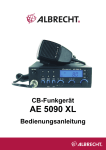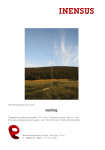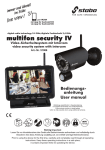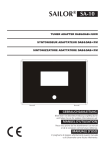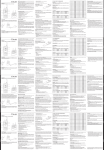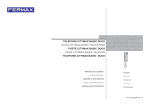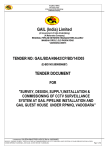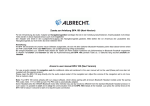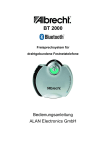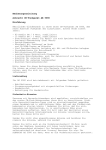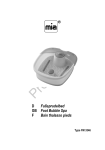Download BPA 200 - Alan-Albrecht Service
Transcript
BPA 200 Drahtlos-Adapter für Sprechfunkgeräte Allgemeines zum Adapter Set Bluetooth Headsets (Kopfhörer mit Mikrofon) sind in vielen Varianten im Handel erhältlich. Sie alle sind von den Herstellern primär zum Anschluss an Handy’s mit Bluetooth® Technologie vorgesehen. Der ALBRECHT Adapter stellt eine Lösung bereit, mit der ein handelsübliches Bluetooth Headset auch an Handsprechfunkgeräten, wie z.B. den ALBRECHT- oder MIDLAND PMR 446- oder ALAN- Betriebsfunkgeräten benutzt werden kann. Dabei wird unser Adapter vom Headset oder anderen Geräten (z.B. Navigator) wie ein Handy „behandelt“. Systemvoraussetzungen Voraussetzung ist, dass das verwendete Headset das genormte Bluetooth Headset- Protokoll unterstützt. Neben den einfachen Bluetooth- Hörern und mit Bluetooth ausgerüsteten Motorradhelmen gibt es u.a. auch komplexere KFZ Freisprechanlagen, die andere Protokolle unterstützen, wie z.B. das HandsfreeProtokoll. Derartige Geräte müssen, um an unserem Adapter verwendet werden zu können, ggf. erst auf das Standard Headset- Protokoll umgeschaltet werden. Bitte lesen Sie die entsprechende Bedienungsanleitung oder lassen Sie sich vom Händler Ihrer Sprecheinrichtung beraten. Lieferumfang • Wasserdichter Adapter mit eingebauter PTT-Taste, mit CSR Bluetooth V 2.00 Chipsatz und LithiumIonen Akku. • Steckerladegerät zum Aufladen des Adapters am 230 V Stromnetz. • Kabeladaper zum Anschluss an fast alle üblichen Funkgeräte mit Duo-Norm-Buchsen 2.5 / 3.5 mm. Bitte benutzen Sie nur das mitgelieferte Zubehör! Laden Sie bitte den drahtlosen Adapter nur mit dem mitgelieferten Steckernetzteil oder optional erhältlichen 12 V Ladeadapter auf. Andere Netzteile oder Ladegeräte können den Adapter und den eingebauten Lithium-Ionen-Akku beschädigen. Öffnen Sie bitte nie den Adapter oder das Ladegerät und versuchen Sie nie, den Lithium Akku selbst zu wechseln oder gar zu öffnen. Falsche Handhabung von Lithium-Ionen-Akkus, wie z.B. ein versehentlicher Kurzschluss kann in kürzester Zeit zur Explosion des Akkus mit Folgeschäden und gesundheitlichen Risiken führen. Aufladen des Adapters am 230 V Stromnetz Nach Anschluss des Steckerladegeräts werden etwa 1.5 bis 2.5 Stunden benötigt, um ein vollständig entleertes Gerät komplett zu laden. Die Leuchtdiode am Adapter informiert über den Ladevorgang. (rot leuchtet = Ladung). Wird später während des Betriebs der Akku leer, beginnt die Leuchtdiode im Adapter in Abständen rot zu blinken. Sie haben dann noch ca. 10 Minuten Zeit, das laufende Gespräch zu beenden. Ein- und Ausschalten des Adapters Zum Ein- und Ausschalten (sowie zum späteren Pairingvorgang) dient die kleine blaue Drucktaste am Adapter. Ein-/AUS-Taste • Drücken Sie ca. 3 Sekunden lang auf die Taste. Die grüne Leuchtdiode wird dann mehrfach blinken. Dies bedeutet „eingeschaltet“ Danach bleibt das Gerät im Bereitschaftszustand und zeigt das durch kurzes Blinken alle paar Sekunden an. • Drücken Sie jetzt nochmal 3 Sekunden auf den Taster, dann blinkt stattdessen die rote LED. Dies ist der ausgeschaltete Zustand PTT-Taste LEDs (rot/grün) Verbinden des Adapters mit einem Bluetooth® Headset Das System aus Adapter und Headset baut eine abhörsichere Verbindung auf. Dazu müssen die beiden Geräte zunächst einmal die Informationen austauschen, die sie benötigen, um sich gegenseitig als Partnergeräte zu erkennen. Dieser Vorgang wird als „Pairing“ bezeichnet. Es ist wichtig, denn Sie möchten ja sicher nicht gerne, dass andere Bluetooth® oder –kompatible Geräte in Ihrer Umgebung sich versehentlich mit Ihrem Funkgerät verbinden oder umgekehrt. Ausgangspunkt ist ein voll aufgeladener und ausgeschalteter Adapter (wie z.B. im Lieferzustand nach dem ersten Aufladen. Im Zweifelsfall überprüfen Sie mit dem Taster den Zustand und schalten den Adapter aus). • Drücken Sie die Taste auf dem Adapter ca. 6 Sekunden lang. Nach den ersten 3 Sekunden wird sich Ihr Adapter einschalten (grünes Blinken). • Halten Sie die Taste aber weiter gedrückt, bis nach insgesamt ca. 6 Sekunden die rote und grüne Leuchtdiode abwechselnd anfangen zu blinken Nun ist Ihr Adapter im Pairing Mode und kann sich mit einem Headset verbinden. Sie haben nun ca. 45 Sekunden Zeit, den gleichen Vorgang auch bei Ihrem Headset zu starten Pairing Mode beim Headset oder Navigator starten Beim Headset starten Sie bitte ebenfalls den Pairing Vorgang entsprechend der Bedienungsanleitung des Headsets. Bei den meisten Headsets wird der Pairing Vorgang durch schnelleres Blinken von Leuchtdioden angezeigt. Sobald zwei Geräte sich aufeinander eingestellt haben, erlischt das schnellere Blinken. Ihr BPA 200 ist bereits mit unserer neuen Software ausgerüstet, die sich mit allen üblichen Bluetooth Headsets pairen lässt (diese können einen der PIN Codes 1234, 1111 oder 0000 haben). Die Codeanpassung erfolgt automatisch. Bei einigen Headsets (z.B. VEMAR Helm) haben die Tasten am Helm andere Funktionen als üblicherweise im Bluetooth Protokoll vorgesehen. In diesem Fall starten und beenden Sie bitte die Funkverbindung am BPA 200 (zentrale Taste ca. ½ Sekunde lang drücken) anstelle am Headset. Pairing Mode bei Navigatoren starten: Einige Navigatoren , z.B. Garmin ZUMO, haben eine abweichende Pairingmethode, bei ihnen erfolgt die Einleitung des Pairing Vorgangs immer am Navigator. Eine Abfrage des PIN Codes am Navigator ist z.B. beim Garmin ZUMO notwendig. Geben Sie bitte in diesem Fall 1234 als Pairing-Code ein. Bluetooth-Adapter mit Funkgerät verbinden und Gesprächszustand herstellen • Adapter BPA 200 ausschließlich über den mitgelieferten Kabel-Adapter mit der Headset-Duo-Klinkenbuchse des Funkgeräts verbinden. Funkgerät einschalten und auf mittlere Lautstärke stellen. Den Adapter können Sie zwar in der Nähe des Funkgeräts platzieren, aber nicht unmittelbar neben der Antenne des Funkgeräts! • Nach dem Pairing bleibt der Adapter zunächst eingeschaltet in Bereitschaft (StandBy). Etwa alle 2 Sekunden blinkt die grüne LED kurz auf. • Schalten Sie nun das Headset ein. In der Bedienungsanleitung ist meistens die Gesprächstaste beschrieben. • Der Gesprächszustand wird durch das Headset bestimmt: Solange das Headset eingeschaltet bleibt (da die meisten Headsets nur für die Verwendung am Handy beschrieben sind, ist damit der Gesprächszustand eines Telefonats gemeint), bleibt die Verbindung zum Adapter und Funkgerät bestehen. • Durch Drücken des Gesprächsknopfs an Ihrem Bluetooth® Headset können Sie die Verbindung zum Funkgerät einschalten. Es dauert immer einen kurzen Moment, bis die Umschaltung stattgefunden hat. Sie sehen nach kurzer Zeit am Adapter die grüne Leuchtdiode dauernd aufleuchten. Dies ist das Zeichen, dass die Verbindung hergestellt ist. • Stellen Sie die Hörerlautstärke durch Drücken der Lautstärketasten am Headset zunächst auf ein Minimum ein. Öffnen Sie testweise die Rauschsperre am Funkgerät (z.B. mit der Monitortaste). Wenn Sie das Rauschen hören, regulieren Sie am Headset und ggf. am Funkgerät die gewünschte Lautstärke ein. • Zum Sprechen über den Funkweg drücken Sie die PTT Taste (die große blaue Taste in der Mitte des Bluetooth-Adapters) und sprechen Sie über das Headset. Zum Empfang lassen Sie die Taste wieder los. Schalten Sie nichts am Headset um! • Erst wenn Sie den Funk nicht mehr benötigen, sollten Sie die Übertragung am Headset abschalten. Nach Gebrauch können Sie dann auch den Adapter wieder ausschalten. Wichtige Hinweise zum Funkbetrieb: Anders als beim Telefonieren mit dem Handy muss beim Funkbetrieb das Headset dauernd (d.h. also auch bei Empfangsbereitschaft!) eingeschaltet bleiben. Es bleibt also gewissermaßen immer im Gesprächszustand. Nur so sind Sie auch über Funk jederzeit anrufbar! Die PTT Taste ist beim Sprechfunk notwendig, da hier im Gegensatz zum Handy zwischen Senden und Empfang abgewechselt wird. Da Funkbetrieb mit automatischer Sprachsteuerung bei Motorradfunk und seinen unvermeidbaren Fahrgeräuschen bei höheren Geschwindigkeiten unweigerlich zu Fehlsteuerungen beim Sender führen und Sie damit unwissentlich den Sprechkanal blockieren können, wurde von uns eine VOX-Funktion bei diesem Bluetooth-Adapter nicht vorgesehen. Vergessen Sie nicht, vor Gebrauch Adapter und Headset aufzuladen. Auch wenn der Adapter ausgeschaltet ist, fließt ein geringer Entladestrom- wie bei allen Li Ionen-Akkus und kann in kurzer Zeit den Akku entladen. Zurücksetzen bei Fehlfunktionen oder Ummelden des Headsets auf ein anderes Gerät Sollte aus nicht erklärlichen Gründen einmal ein Pairingvorgang versagt haben oder keine Verbindung mehr herstellbar sein, dann schalten Sie bitte Adapter und Headset aus und starten Sie einen neuen Pairingvorgang. Das gleiche machen Sie bitte, wenn Sie zwischendurch das Headset z.B. an einem Handy anstelle des Funkgeräts benutzen möchten (Ausnahme: Multi Pairing Headsets benötigen kein neues Pairing beim Wechsel). Anschlussbedingungen für Funkgeräte • Funkgerät mit Duo-Klinkensteckerbuchse für Mikrofon (2.5mm) und Lautsprecher (3.5mm) • Es sind nur Funkgeräte verwendbar, die keine DC gekoppelte NF Endstufe mit Brückenschaltung verwenden. Die ALAN, ALBRECHT und MIDLAND Funkgeräte mit Duosteckern erfüllen alle diese Forderung. Ein direktes Einstecken des 4 poligen Steckers des BPA 200 ohne Adapter in 2.5 mm Stereobuchsen einiger Funkgeräte ist technisch nicht möglich! (der 4 polige Stecker passt direkt nur in spezielle, kundenspezifisch vorbereitete Funkgeräte) Technische Daten Übertragungssystem Frequenzbereich / Kanäle Sendeleistung Modulation Kanalbelegung Reichweite Betriebszeiten Audio-Prozessing Stromversorgung Netz-Ladegerät Angewendete Europäische Normen Spread-Spectrum , BT-Standard 2.0 + EDR, Class 2 2402 bis 2480 MHz, 79 Kanäle mit je 1 MHz Bandbreite kleiner als + 4 dBm (2.5 mW), automatisch geregelt digitale Verschlüsselung, FHSS, GMSK, 1 Mbit/s Frequency Hopping 625 µs Zeitschlitz max. ca. 10 m Eingeschaltet (StandBy) ca. 1 Woche Gesprächszeit max. ca. 10-12 Stunden PCM Codec Hochleistungs-Lithium Polymer Akku 360 mAh Schaltnetzteil mit automatischer Abschaltung bei voll geladenem Akku EN 300 328-2 V 1.7.1; EN 301 489-01 V 1.8.1 EN 301 489-17 V 1.2.1 ; EN 60950-1 :2006 : 2nd ed. CE Kennzeichnung /Konformität Das Gerät erfüllt die o.a. Normen und ist mit dem CE Zeichen gekennzeichnet. Die Benutzung dieses Geräts ist nach neuesten EU Richtlinien in allen EU und EWR Staaten als „Class 2“ Gerät allgemein freigegeben. Bitte beachten Sie trotzdem evtl. Einschränkungen, die immer noch in einigen Ländern für die angeschlossenen Funkgeräte gelten! Den jeweils neuesten Stand von Konformitätserklärung und Gerätepapieren finden Sie u.a. auf unserer Serviceseite unter http://www.alan-albrecht.info Sicherheitshinweis Obwohl die Sendeleistung von drahtlosen Systemen dieser Art weit unter (bis zu Faktor 1000) den Strahlungsleistungen von Mobiltelefonen (Handys) liegt und allgemein als unbedenklich angesehen wird, sind in sensiblen Bereichen, wie medizinischen Einrichtungen oder in Flugzeugen Beeinflussungen anderer elektronischer Geräte nicht auszuschließen. Daher müssen alle Funkanlagen, ® auch Bluetooth Geräte in solchen Bereichen ausgeschaltet bleiben bzw. dürfen nur nach Rücksprache betrieben werden. Die gleichen Einschränkungen gelten auch für den Betrieb der mit dem Adapter verbundenen Funkgeräte! Hinweise zum Recycling nach dem Elektrogerätegesetz Dieses Gerät entspricht der neuen europäischen RoHS Richtlinie. Sollte das Gerät eines Tages defekt werden oder nicht mehr gebraucht werden, dann darf es nicht mehr über den Hausmüll entsorgt werden, sondern muss bei den extra für Elektronikschrott eingerichteten kommunalen Sammelstellen abgegeben werden (für Endverbraucher kostenfrei). Sie unterstützen uns damit beim Recycling wertvoller Rohstoffe und leisten gleichzeitig einen Beitrag zum Umweltschutz! © Alan Electronics GmbH (Februar 2012) Technische Hotline: e- Mail: Service -Webseite: 01805-012204 (0.14 Euro/Minute aus dem deutschen Festnetz, aus den Mobilfunknetzen sind andere Tarife mit max. 0.42 Euro/min möglich) [email protected] http://www.service.alan-electronics.de or http://www.alan-albrecht.info BPA 200 Wireless Adapter for 2 Way Handheld Radios General remarks Many kinds of Bluetooth Headsets are available on the market. They all are designed for use together with cellular phones with Bluetooth® technology. The ALBRECHT Adapter BPA 200 is a unique solution, which allows to connect any standard Bluetooth headset for private and professional 2-way radios, like ALBRECHT-, MIDLAND PMR 446 or ALAN commercial hand held radios. In all cases, the other Bluetooth Device (can be a Headset or GPS navigator) will regard our adapter as a “Mobile phone”. System Requirements The headset must support the BT Standard Headset Protocol. Besides standard headsets and Bluetooth motor bike helmets there are also some Bluetooth handsfree kits for car installation on the market, which support different protocols, like the Bluetooth Handsfree Protocol. Because this is different from the Headset protocol, such more sophisticated handsfree systems must be able to be adapted by software switching to the headset protocol, otherwise they cannot be used with the ALBRECHT adapter. Please read the instruction manuals or better consult the distributor of the headset/ handsfree set. Package includes • Adapter with integrated Bluetooth® chipset and rechargeable Li-Ion battery. • 230 V charger to charge the adapter from 230 V AC. • Radio Connecting Cable to connect the adapter to 2-way handheld radios with DUO plugs 2.5/3.5 mm. • Waterproof Adapter with integrated Push-To-Talk Key (PTT) • Note: Please use only our recommended or supplied accessory items! Please use only the supplied accessories. Operate the Bluetooth adapter only in connection with the specially designed wall charger or approved original DC adapter for your vehicle, other chargers may damage the device or the Li-Ion battery inside. Never open the adapter, the charging device or try to change or even open the lithium battery by yourself! Any manipulation at the Li-Ion battery, such as short circuits etc, may cause fire or even explosion and severe injuries to persons. Charging the Adapter with 230 V AC Charging starts the moment the wall charger is connected with the adapter. 1.5 to 2.5 hours are being needed to fully charge a completely empty adapter. The LED indicator light gives you information of the state of charging (red is flashing = charging, red off = battery full). When the battery becomes empty during use, the red LED will start flashing from time to time. Switching On and Off There is a single multi-purpose function button on the adapter, which is used for ON-OFF and pairing as well (the smaller one). On/Off-Button • • • PTT-Button Press button for at least 3 seconds. The green to show “on” LED will flash After this, the adapter will be in standby mode (flashing green from time to time). Press again the button for 3 seconds, now the red LED will flash several times. This is the “off” position. LEDs (red/green) Connecting the Adapter with a Bluetooth® Headset Your system of adapter and headset can establish a connection that protects you from eaves-dropping. To do so the system needs information to identify your headset as its exclusive partner. This procedure is called „pairing“. This is very important because you don`t want any other headsets in your vicinity to coincidentally be connected with your radio or vice versa. You have to start this pairing process with fully charged adapter and headset. It is necessary to switch the adapter off before pairing. If You are not sure, switch the adapter off by the already described procedure. For the headset side, please read about the pairing process in the instruction manual of the headset. • Press the function key of the adapter for at least 6 seconds. After the first 3 seconds You will observe that the adapter switches on (green LED is flashing). • Do not release the button, keep it pressed for another 3 seconds. Finally You will see an alternating flashing of the red and green LED’s. Now Your adapter has entered the pairing mode and is searching for other Bluetooth devices nearby, like Your headset. You will have about 45 seconds time to start the appropriate pairing procedure at the Headset, too. Starting Pairing Mode of Headset or other device (like GPS Navigator) The pairing mode of the Headset is described in the user manual of Your headset. Please follow the user instructions. Most headsets show the pairing mode by a faster flashing of LED’s. As soon as both devices have found each other, the fast flashing will stop. Both systems remain automatically in their standby modes. Your BPA 200 comes already with our unique software, which allows pairing with all known Bluetooth Headset models under the pairing PIN codes 1234, 1111 or 0000 as well. The PIN code is automatically adopted. Some Headsets (like the VEMAR Bluetooth motor bike helmet) may use key functions different from the standard Bluetooth headset protocol. In such cases it is possible to start and to stop the communication link at the BPA 200 instead at the headset. Just press the small knob at the BPA 200 for about ½ second to start or to stop communication. If You should combine the adapter with a Navigator like Garmin ZUMO, the navigator may require a slightly different method. Start the pairing process at the navigator, which will treat the adaptor as a “mobile phone” and will ask for the PIN code. In that case enter 1234. Connecting the 2 way Radio and starting Conversation Mode • Connect the radio cable to the 2 way radio’s 2.5mm or 2.5/3.5 mm mic/earphone socket. Switch radio on and adjust to medium volume. Please avoid to place the adapter too near to the radio’s antenna! • After pairing the adapter is in standby mode (green LED is flashing every 2 seconds). • Switch the headset from standby mode to “Call” or “Talk”. In the user manual this is described as starting a phone conversation. In most cases You will find a “Talk” button. • Starting and stopping the communication link will be done at the headset side. As long as You need the radio communication (including the receive periods!) the headset must stay in the „Talk“ or „Call“ position, whatever the user manual describes. Please note that the user manual describes telephone conversation and not a 2-way radio conversation. • Start the connection to Your 2-way radio by using the Talk / Call button of the wireless headset. It will always take a small moment, until You can see that the communication link is established. You will see the green LED on the adapter side permanently on. This demonstrates, that connection is successful • Adjust the headset volume at first to minimum to avoid any risk of acoustical shock. Open the squelch of the radio for testing (or press the monitor button). You will hear the white noise from the 2 way radio. You may now adjust the volume at the headset according to Your needs. Do not adjust the volume of the radio too loud, this may provide distortion • • • • To talk via radio press the PTT key (the large button in the middle of Your Bluetooth-Adapter) and talk via Your headset To receive again, You release the PTT key again. Please do not switch anything at the headset side! If You do not want to listen any more to Your radio channel, You should disconnect the connection from the headset side only (Talk or Call button). The adapter at the radio side will then automatically switch back to standby mode. Please switch both devices completely off, when You do not need them. Important notes explaining different characteristics of radio and cellular phone When using cellular phones, You only need to use the Talk/Call button of Your headset when You start a phone call or answer a phone call. In receive mode of a two-way-radio, You must ensure, that at any time incoming audio from other stations can be transmitted to the headset side. So the headset side must always remain switched into Talk/Call mode, or you cannot hear what happens on the radio channel! A PTT key is necessary in 2-way-radio communications, because many users share a common channeldifferent from cellular phone, where a duplex connection to your partner is established during the conversation. A VOX-function is not possible, when You are using this Bluetooth-Adapter. Do not forget to charge both adapter and headset before each use. Even if the adapter is switched off, a small leakage current will discharge Li-Ion batteries slowly, but continuously. This is common to all devices with LiIon batteries. Reset and / or pairing with other devices It may happen that a pairing procedure was not successful. In that case switch both units off, connect and disconnect the device for a moment to the charger or start a new pairing procedure. Normally both devices save their pairing information in a non volatile memory, so you do not need to repeat the procedure before next use, just switch on- that’s it. If you should need to use the headset for another device, like cellular phone, You must normally repeat the pairing when returning to the 2-way-radio adapter. Some headsets on the market allow multi-pairing functions. in that case no repeated pairing is necessary when returning on the radio. Interface requirements for 2-Way-Radios • Radio with double audio sockets for mic (2.5 mm) and speaker /phone (3.5 mm) • Only radios can be used which have conventional grounded audio outputs. DC coupled bridge amplifier outputs cannot work with our adapter. All ALAN and many other radios with Duo plugs 2.5 mm / 3.5 mm can be used. • The adapter cannot be used alone with it’s 4 pole multi-plug for direct connections to radios with a 2.5 mm stereo socket. The 4 pole plug fits only to special custom-made radio models. Technical Data Wireless transmission system Frequency range / channels Radiated transmission power (ERP) Modulation Channel occupancy system Maximum communication distance Operating time Audio-processing Adaptor power supply Charging system Applied European Standards CE Marking & Conformity Declaration Safety notes Spread-Spectrum Bluetooth Standard 2.0 + EDR, Class 2 2402 to 2480 MHz, 79 channels with 1 MHz bandwidth per channel less than + 4 dBm (2.5 mW), with automatic power control digital encryption, FHSS, GMSK, 1 Mbit/s frequency hopping 625 µs time slot max. approx. 10 m switched on (StandBy) max. appr. 1 week talk time max. appr. 10-12 hours PCM Codec high power rechargeable lithium polymere battery 360 mAh 230 V switching power supply charger with automatic full battery detecting EN 300 328-2 V 1.7.1; EN 301 489-01 V 1.8.1 nd EN 301 489-17 V 1.2.1 ; EN 60950-1:2006:2 ed. This unit is produced according to the above mentioned European Standards and is marked with CE. According to the latest European Regulations, this h device is a BT class 2 equipment which can be used without restrictions in all EU and associated countries which apply the R&TTE directive. Please be aware that other restrictions may still be in force for the 2 way radio connected with your wireless adapter. Our latest issue of Conformity Declaration and product documentation can be downloaded from our service homepage under http://www.alan-albrecht.info While the transmitting power of this kind of wireless systems is far below (up to a factor of 1000) the radiated power levels of hand held GSM phones and is generally not regarded as dangerous, interference effects between radio transmitters and other electronic devices cannot be excluded in sensitive environments, like medical centers, and airplanes. Operators may request that wireless devices must remain switched off in such areas. The same restrictions apply for the radios connected with the device. Recycling information This product is RoHS conform. According to latest European regulations, it is no more allowed to dispose electronic items into the normal household trash. Collecting and recycling facilities have been installed in all communities, where You can dispose no more used electronic items free of charge. Doing this, You can contribute to the industry’s recycling policy and environment protection! © Alan Electronics GmbH (February 2012) Technical Hotline / Repair inquiries: 01805-012204 (14 cents per minute from German fixed phone network) e- Mail: [email protected] Service Download http://www.alan-albrecht.info or http://www.service.alan-electronics.de BPA 200 Adaptador inalámbrico para walkie-talkies Observaciones generales En el mercado hay disponibles muchos tipos de auriculares Bluetooth. Todos ellos han sido diseñados para su uso junto con un teléfono móvil con tecnología Bluetooth. El adaptador ALBRECHT BPA 200 es la única solución que permite conectar un auricular Bluetooth estándar con un talkie, de uso profesional o privado, como ALBRECHT, MIDLAND PMR 446 o radios comerciales ALAN. En todos los casos, el otro dispositivo Bluetooth (puede ser un auricular o un navegador) verá a nuestro dispositivo como un teléfono móvil. Requerimientos del sistema El auricular debe soportar el protocolo de auriculares estándar. Los kit de manos libres de instalación en vehículos, disponen del protocolo manos libres, el cual es diferente al de auriculares. Como estos protocolos son diferentes, los sistemas manos libres más sofisticados deben de poder adaptarse por software al protocolo auricular, de lo contrario no se podrán usar con el adaptador ALBRECHT. Por favor, lea el manual de instrucciones o consulte con su distribuidor. El embalaje incluye • Adaptador Impermeable Bluetooth con tecla PTT y con batería recargable de Li-Ion. • Cargador con conexión a 220V AC. • Cable conexión a la radio para conectar el adaptador a un talkie con doble jack 2.5/3.5 mm. Nota: ¡Utilice solamente nuestros accesorios suministrados o recomendados! Ultilice los accesorios suministrados. Cargue el adaptador Bluetooth solamente con el cargador suministrado o con un cargador de mechero recomendado por ALAN. El uso de otros cargadores puede causar daños al adaptador o a la batería. No abra nunca el adaptador, el cargador o trate de cambiar la batería usted mismo. Cualquier manipulación de la batería puede causar un cortocircuito y provocar fuego o incluso explosión, causando daños a las personas cercanas. Carga del adaptador La carga comienza cuando conectamos el cargador con el adaptador, siendo necesarias entre 1,5 y 2.5 horas para cargar completamente un adaptador descargado completamente. El indicador LED informa del estado de la carga (parpadeo rojo = en carga, apagado = carga completada). Cuando la batería se descarga durante el uso, el LED parpadea en rojo de vez en cuando. Encendido / Apagado (On/Off) El adaptador tiene una tecla multifunción que se usa para el encendido y apagado (la más pequeña). Tecla On/Off • • • Tecla PTT LED (rojo/verde) Pulse la tecla durante 3 segundos. El LED parpadea en verde para indicar el modo “on” (encendido). Después el adaptador queda en espera y el LED parpadea en verde de vez en cuando Pulse de nuevo la tecla durante 3 segundos. Ahora el LED parpadea en rojo varias veces, indicando el modo “off” (apagado). Conexión del adaptador con un auricular Bluetooth® El sistema de adaptador y auriculares establece una conexión que le protege de escuchas. Para ello, el sistema necesita información para identificar el auricular como su compañero exclusivo. Este proceso se denomina sincronización y una vez conectados, no habrá ningún otro dispositivo cercano que pueda conectarse casual o accidentalmente. El proceso de sincronización hay que realizarlo con el adaptador y el auricular totalmente cargados. El adaptador debe de estar apagado para comenzar este proceso. Lea el manual de instrucciones del auricular para poder completar con éxito el proceso de sincronización. • Pulse la tecla de función (On/Off) al menos durante 6 segundos. Después de los primeros 3 segundos observará que el adaptador se enciende y el LED parpadea en verde • No suelte la tecla y aguante otros 3 segundos. Observará finalmente que el LED parpadea alternativamente rojo y verde • Ahora el adaptador está en modo “sincronización” y está buscando otros dispositivos Bluetooth cercanos, como su auricular. Tendrá unos 45 segundos para comenzar el proceso de sincronización. Comienzo de la sincronización con el articular u otro dispositivo (p.e. un navegador) El proceso de sincronización del auricular se describe en el manual de usuario del propio auricular. La mayoría de auriculares muestra el modo sincronización mediante rápidos parpadeos del LED. Tan pronto como los dos dispositivos se encuentran, el parpadeo se detiene y pasan a modo espera. Su BPA 200 ya viene con el software que le permite sincronizarlo con todos los modelos conocidos de auricular que utilizan los PIN 1234, 1111 o 0000. Como no existe teclado, el PIN se toma automáticamente. Algunos auriculares (como el casco con Bluetooth VEMAR) pueden usar un protocolo diferente del estándar para auriculares. En esos casos es posible comenzar y terminar la comunicación desde el BPA 200 en vez de desde el auricular. Pulse brevemente la tecla de función (sobre ½ segundo) para activar o parar la comunicación. Si quiere sincronizar el adaptador con un Navegador como el Garmin ZUMO, el navegador puede requerir un proceso ligeramente diferente. El navegador reconoce el BPA 200 como un teléfono móvil y pide un código PIN. En este caso, introducir el código 1234. Conexión de un talkie y comienzo del modo conversación • Conecte el cable al conector de la radio 2.5mm o 2.5/3.5 mm. Encienda la radio y ajuste un volumen medio. Evite colocar el adaptador cerca de la antena de la radio • Después de la sincronización, el adaptador está en modo espera (el LED parpadea en verde cada 2 segundos). • Encienda el auricular. En el manual de usuario se describe como comienzo de una conversación telefónica. En la mayoría de los casos encontrará una tecla de “Call” o “Talk”. • El comienzo y finalización de la comunicación, se hace desde el auricular. El auricular debe de estar siempre en modo “Call” o “Talk” ya que se necesita tanto para transmisión como para recepción. Tenga en cuenta que el manual describe conversaciones de teléfono, no comunicaciones de talkie. • Comience la conexión a su talkie utilizando la tecla Talk / Call del auricular. El tiempo de conexión es muy breve y se puede comprobar mediante el LED del adaptador, el cual se enciende permanentemente en verde. Esto nos indica que la conexión se ha realizado con éxito • Al principio, ajuste el volumen de auricular al mínimo para evitar riesgos de shock acústico. Abra el squelch de la radio o pulse la tecla monitor para verificar el volumen. Escuchará el ruido de fondo en la radio. Ahora puede ajustar el volumen del auricular al nivel adecuado que desee. No ajuste el volumen de la radio muy alto ya que podría causar distorsión. • Para hablar, pulse la tecla PTT (la tecla grande en el adaptador) y hable a través de su auricular. • Para pasar a recepción, suelte la tecla PTT. ¡No toque nada en el auricular! • Si no quiere utilizar la radio, debe desconectar solamente desde el auricular (tecla Talk o Call). El adaptador volverá al modo espera. • Apague completamente los dos dispositivos cuando no los vaya a utilizar más. Diferencias entre teléfono móvil y walkie-talkie Cuando utilice un teléfono móvil solamente necesita la tecla Talk/Call para comenzar o responder una llamada. En modo recepción con un talkie, debe asegurarse que la señal entrante sea enviada al auricular, de manera que el auricular tiene que estar siempre en modo Talk/Call, o de lo contrario no escuchará ninguna transmisión. En las comunicaciones con talkie-talkies es necesaria una tecla PTT, porque varios usuarios comparten un canal, a diferencia de los teléfonos, donde una conexión duplex permite estar hablando y escuchando a la vez. Una función VOX no es posible cuando esté usando este Adaptador Bluetooth. No olvide cargar tanto el adaptador como el auricular antes de cada uso. Aunque se encuentren apagados, una pequeña corriente descargará las baterías lenta pero constantemente. Este efecto es común a todos los dispositivos con baterías de Li-Ion. Reset y / o sincronización con otros dispositivos Es posible que un proceso de sincronización no resulte exitoso. En ese caso apague los dos dispositivos y comience un nuevo proceso de sincronización. Normalmente las dos unidades guardan la información de sincronización en memorias no volátiles, por lo que no tendrá que repetir los procesos después de la primera utilización. Si necesita usar el auricular con otro dispositivo, como un teléfono, cuando vuelva a utilizarlo con un talkie deberá repetir el proceso de sincronización. Algunos auriculares del mercado soportan varios dispositivos sincronizados. En tal caso no seria necesario volver a sincronizarlos. Interface necesario para walkie-talkies • Un jack estéreo doble jack 2.5/3.5 mm • Solamente se pueden utilizar radios convencionales y no a través de amplificador. Todas las radios ALAN y otras muchas pueden funcionar con su BPA 200. Datos técnicos Sistema de transmisión Wireless Rango de frecuencia / canales Potencia de transmisión radiada (ERP) Modulación Sistema de ocupación de canal Distancia máxima de comunicación Duración de la batería Audio-proceso Alimentación Carga Estándares europeos Declaración de conformidad CE Notas de seguridad Spread-Spectrum Bluetooth Standard 2.0 + EDR, Clase 2 2402 a 2480 MHz, 79 canales, 1 MHz de ancho de banda por canal menos de + 4 dBm (2.5 mW), con control de potencia automático encriptación digital, FHSS, GMSK, 1 Mbit/s saltos de frecuencia cada 625 µs aproximadamente 10 m en espera (StandBy) 1 semana aprox. En conversación 10-12 horas aprox. PCM Codec batería de alta potencia de polímero de litio 360 mAh cargador con fuente de alimentación conmutada de 230 V con detector automático de batería cargada EN 300 328-2 V 1.7.1; EN 301 489-01 V 1.8.1 EN 301 489-17 V 1.2.1; EN 60950-1:2006 2nd ed. Este dispositivo ha sido fabricado siguiendo los estándares europeos mencionados y lleva marcado CE. De acuerdo con las últimas regulaciones europeas, este dispositivo es un Bluetooth clase 2 y puede ser usado sin restricciones en toda la UE y países asociado que aplican la directiva R&TTE. Tenga en cuenta que los talkies conectados a este dispositivo, SI pueden estar sometidos a alguna restricción. Como la potencia de transmisión de este sistema inalámbrico es bastante más baja (hasta un factor de 1000) que la radiada por un teléfono móvil, no se contempla como peligrosa. En ambientes sensibles, como centros médicos o aviones, no se puede descartar que pueda producir algún tipo de interferencias en otros aparatos electrónicos. Por ello, los responsables de estas áreas, pueden pedir que los dispositivos inalámbricos permanezcan apagados. Estas mismas restricciones son aplicables a los talkies conectados a este dispositivo. Información sobre reciclaje Este producto cumple con la normativa RoHS. De acuerdo con las últimas regulaciones europeas, no está permitido depositar dispositivos electrónicos en la basura orgánica. Por favor deposite estos dispositivos en los puntos verdes destinados a tal efecto. De esta manera, contribuye con las políticas de reciclaje y con la protección del medio ambiente. Alan Communications, S. A. (02/2012) Telf.: 902384878 Fax: 933779155 E-Mail: [email protected] Sitio web: http://www.alan.es












